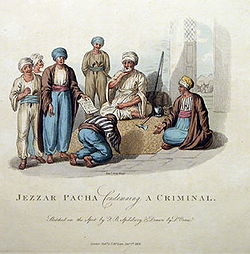- Jezzar Pasha
-
Ahmed al-Jazzar (Arabic أحمد الجزار, Ottoman Turkish "Ahmet Bey" or "Cezzar Paşa" born 1720 (or in 1708) in Stolac in Bosnia, died 1804 in Acre, Damascus Wiliyah) was the Ottoman ruler of Acre and the Galilee from 1775 until his death.
Contents
Biography
Jazzar Pasha was a Christian slave boy from Bosnia who, escaping after committing a murder, sold himself to the slave -markets of Istanbul. There he was bought by an Egyptian ruler who converted him to Islam and used him as his chief executioner and hit-man. He began his rise as governor of Cairo but made his name defending Beirut against Catherine the Great´s navy. Beirut was honorably surrendered to the Russians after a long siege and the sultan rewarded al-Jazzar with promotion to Governor of Sidon, and sometimes also that of Damascus. He set up his capital in Acre after the fall of Dhaher al-Omar. He earned the nickname "the Butcher" for his cruelty and extortion of his subjects.[1] He is reputed to have walked around with a mobile gallows in case anyone displeased him.[2]
Defense of Acre
Jazzar Pasha is best known for defending Acre against Napoleon Bonaparte during the siege of Acre in 1799.[3] After Napoleon's capture of Egypt, then an Ottoman territory, the French army attempted to invade Syria and Palestine. Although the French captured Al-Arish and Jaffa, and won every battle they fought against the Ottomans on an open field, they were unable to breach the fortifications of Acre. Their army was weakened by disease and cut off from resupply. The success was due to the english Commodore William Sidney Smith too, who sailed to Acre and helped the Turkish commander reinforce the defences and old walls and supplied him with additional cannon manned by sailors and Marines from his ships. Smith also used his command of the sea to capture the French siege artillery being sent by ship from Egypt and to deny the French army the use of the coastal road from Jaffa by bombarding the troops from the sea.
Though both Napoleon and Jazzar requested assistance from the Shihab leader, Bashir, ruler of much of present-day Lebanon, Bashir remained neutral. After several months of attacks, Napoleon was forced to withdraw and his bid to conquer Egypt and the East failed.
Building activity
With the help of his chief financial adviser, Haim Farhi, a Damascus Jew, Jezzar Pasha embarked on a major building program in Acre that included fortifying the city walls, refurbishing the aqueduct that brought spring water from nearby Kabri, and building a large Turkish bath. One of the most important landmarks built by Jezzar Pasha was the mosque that bears his name, a massive building in the Turkish style. Built over a Crusader church, the al-Jezzar Mosque incorporates columns brought from Roman and Byzantine ruins in Caesarea and Tyre, and included a school for Islamic religious studies, later used as a religious court. Al-Jezzar and his adopted son and successor Suleiman Pasha, were buried in the courtyard.[2]
References
External links
- Jezzar Pasha and the Jews, The Jews in Palestine in the 18th Century
- Description of the town of Acre, Travels in Palestine, 1821, James Buckingham
Preceded by
Dhaher al-Omarruler of Galilee
1775—1804Succeeded by
Suleiman PashaCategories:- History of the Ottoman Empire
- Ottoman political people
- Ottoman military leaders of the French Revolutionary Wars
- History of Israel
- History of Palestine
- 1804 deaths
- People from Stolac
- Ottoman governors of Damascus
Wikimedia Foundation. 2010.


